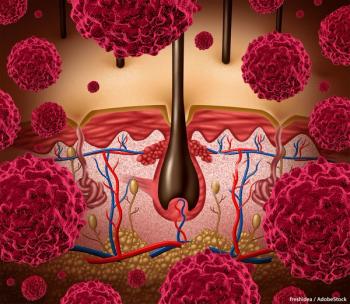
Sorafenib Doesn’t Improve Response to Isolated Limb Infusion in Extremity Melanoma
The addition of sorafenib to isolated limb infusion therapy with melphalan did not improve responses in a new phase I trial of patients with in-transit extremity melanoma.
The addition of sorafenib to isolated limb infusion therapy with melphalan did not improve responses in a new phase I trial of patients with in-transit extremity melanoma.
Photograph of an asymmetrical, brown lesion on the skin on the bottom of the foot.
Between 2% and 10% of melanoma lesions on the extremities will recur as in-transit metastases, and isolated limb infusion with melphalan has emerged as a promising therapy with complete response rates as high as 29%. Because various trials have shown that the oral multikinase inhibitor sorafenib could augment the antitumor activity of cytotoxic agents, researchers led by Georgia M. Beasley, MD, of Duke University Medical Center in Durham, North Carolina, conducted a trial combining sorafenib with isolated limb infusion with melphalan. The results were
“In preclinical studies, sorafenib in combination with melphalan led to significantly improved responses in vitro, and the combination was more effective than either treatment alone in slowing tumor growth in a rat regional-therapy xenograft model of extremity melanoma,” the investigators wrote.
The study included 20 patients at two centers, all with stage IIIB/IIIC/IV melanoma and ECOG performance status of 0 or 1. Patients received sorafenib therapy for the 7 days prior and 7 days following isolated limb infusion with melphalan. The study was designed as a dose escalation study, and dose limiting toxicities eventually showed the maximum tolerated dose of sorafenib to be 400 mg.
Of the 20 patients, only 3 patients (15%) achieved a complete response to the therapy at a 3-month endpoint, while another 4 (20%) achieved a partial response. Two patients had stable disease, and 10 had progressive disease. “Interestingly, regression of at least 1 lesion occurred after 1 week of sorafenib therapy as measured just prior to [isolated limb infusion with melphalan] in 50% of the patients,” the authors wrote.
Fourteen of the 20 patients had received previous melphalan therapy before inclusion in this study; the three complete responses were all in this subgroup, and all three patients had achieved a complete response with prior isolated limb infusion treatment with melphalan alone. Only one of the six chemo-nave patients achieved a partial response in this study.
There was substantial regional toxicity with the combination therapy, with 45% of patients suffering at least grade 3 limb toxicities.
"The addition of sorafenib to regional therapy with melphalan was not able to improve tumor response rates in our multi-center phase I trial of sorafenib and regional melphalan for in-transit melanoma,” Dr. Beasley said in an email to CancerNetwork. “However, this unique disease model allowed us to correlate the expression of tumor proteins with the effects of treatment enabling us to better understand why the combination treatment did not work as well as we had anticipated based on preclinical models."
Specifically, there was no substantial decrease in expression of P-MAPK or P-MEK with sorafenib, and the lack of difference between patients with mutant vs wild-type BRAF suggests that the drug did not inhibit the important BRAF signaling pathway, the authors noted. Further studies could examine if a more selective and potent inhibitor of that pathway might improve results with regionally delivered chemotherapy.
Newsletter
Stay up to date on recent advances in the multidisciplinary approach to cancer.















































































